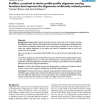327 search results - page 25 / 66 » Optimal detection of sequence similarity by local alignment |
CSB
2003
IEEE
14 years 1 months ago
2003
IEEE
This paper describes a new strategy for designing degenerate primers for a given multiple alignment of amino acid sequences. Degenerate primers are useful for amplifying homologou...
BMCBI
2005
13 years 7 months ago
2005
Background: Profile-profile methods have been used for some years now to detect and align homologous proteins. The best such methods use information from the background distributi...
BMCBI
2006
13 years 7 months ago
2006
Background: In recent times, there has been an exponential rise in the number of protein structures in databases e.g. PDB. So, design of fast algorithms capable of querying such d...
BMCBI
2010
13 years 7 months ago
2010
Background: Computational comparison of two protein structures is the starting point of many methods that build on existing knowledge, such as structure modeling (including modeli...
CIBCB
2005
IEEE
14 years 1 months ago
2005
IEEE
— Part of the challenge of modeling protein sequences is their discrete nature. Many of the most powerful statistical and learning techniques are applicable to points in a Euclid...

